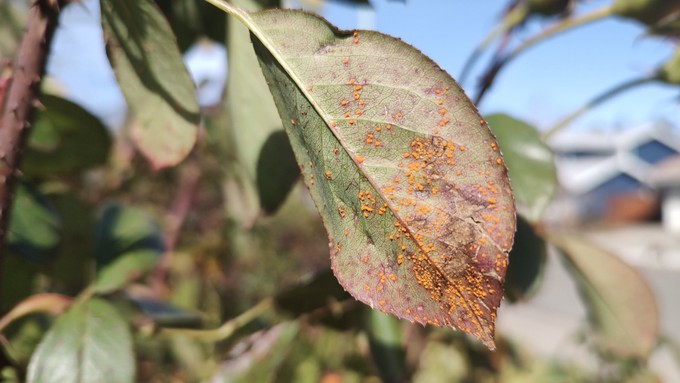
How to tackle fungal outbreaks on roses without spraying

This rose is in the grip of the fungal disease known as rust. Cleanup and warmer weather will end the outbreak. Debbie Arrington
It’s easy to spot: This colorful fungal disease gets its apt nickname from the bright orange spores that form on the underside of leaves. The top surface of foliage becomes speckled with yellow blotches.
And when the conditions are just right – as in right now – this fungal disease can quickly infect a whole rose bush, including all the new healthy shoots trying to grow.
Rose rust – Phragmidium mucronatum – needs moist conditions (such as after a storm or on foggy mornings) and temperatures in the 60s to low 70s. A constant problem in coastal areas, rust hits Sacramento in late winter to early spring and again in the fall, usually November.
This week with abundant moisture and afternoons in the 60s, rust is breaking out all over Sacramento.
This outbreak was just waiting to happen. Rust spores spend their winter dormancy on old leaves – on or off the bush. When bushes aren’t pruned before an outbreak, the spores can spring into action almost overnight. Those spores infect the new tender foliage and cause it to whither before it can develop.
Rust ultimately causes the bush to shed its infected leaves (old and new). Without leaves, a rose bush struggles to survive – never mind producing flowers.
Fortunately, most bushes will sprout new leaves. As our afternoon temperatures warm into the 80s and 90s, rust disappears; it can’t take the heat.
In the meantime, the best way to attack rust is to cut it off. Remove infected leaves and discard in the trash. Fungal sprays are a temporary solution and require repeated spraying (as well as hitting the underside of leaves). Infected leaves will fall off anyway. Skip the spray and remove the rusty foliage before the fungus spreads any further.
If a bush wasn’t pruned this winter, go ahead and prune it now – just not severely. Aim to keep the bush about 3 to 4 feet tall after pruning. Cut off any old foliage and remove any fallen leaves that may have accumulated under the bush.
When pruning, try to improve air flow through the interior of the bush by removing some canes that grow towards the center. (Encourage the bush to grow out, not in.) Better air circulation helps cut down on fungal disease development; foliage dries quicker after rain.
Rake out the old mulch under bushes, too, and replace it with fresh wood chips or other organic mulch. Old mulch can harbor dormant fungal spores, not just rust but powdery mildew and black spot.
To avoid rust outbreaks later in spring, water roses with irrigation underneath the bushes – not overhead. When using water to knock off aphids, spray bushes in the morning so the foliage has a chance to dry before the afternoon.
For more on rose diseases and prevention, check out these recommendations from the UC integrated pest management program:https://ipm.ucanr.edu/PMG/PESTNOTES/pn7463.html.
Comments
0 comments have been posted.Sacramento Digs Gardening to your inbox.
Sites We Like
Garden Checklist for week of July 21
Your garden needs you!
* Keep your vegetable garden watered, mulched and weeded. Water before 8 a.m. to reduce the chance of fungal infection and to conserve moisture.
* Feed vegetable plants bone meal, rock phosphate or other fertilizers high in phosphate to stimulate more blooms and fruiting. (But wait until daily high temperatures drop out of the 100s.)
* Don’t let tomatoes wilt or dry out completely. Give tomatoes a deep watering two to three times a week.
* Harvest vegetables promptly to encourage plants to produce more. Squash especially tends to grow rapidly in hot weather. Keep an eye on zucchini.
* Pinch back chrysanthemums for bushy plants and more flowers in September.
* Remove spent flowers from roses, daylilies and other bloomers as they finish flowering.
* Pinch off blooms from basil so the plant will grow more leaves.
* Cut back lavender after flowering to promote a second bloom.
* It's not too late to add a splash of color. Plant petunias, snapdragons, zinnias and marigolds.
* From seed, plant corn, pumpkins, radishes, winter squash and sunflowers.